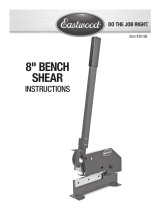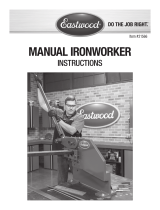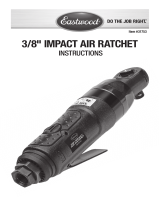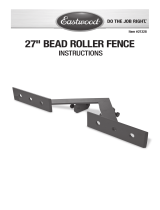Page is loading ...

4" THROATLESS
SHEAR
INS TRUCTIONS
Item #11797

2 Eastwood Technical Assistance: 800.343.9353 >> techelp@eastwood.com
Your EASTWOOD 4” THROATLESS SHEAR for metal cutting is precision designed and manufactured to allow precise control when making straight or
intricately curved cuts of any length, in any direction. Hardened, finely honed blades produce clean, burr-free cuts in aluminum, steel and other mild metals.
The gear-driven design delivers maximum shearing power with minimal handle force.
CONTENTS
(1) 4” Metal Shear
(1) 17” Handle
SPECIFICATIONS
Maximum Cutting Thickness: 14 Gauge Mild Steel
18 Gauge Stainless Steel
DANGER indicates a hazardous situation which, if not avoided, will result in death or serious injury.
WARNING indicates a hazardous situation which, if not avoided, could result in death or serious injury.
CAUTION used with the safety alert symbol, indicates a hazardous situation which, if not avoided, could result in minor or moderate injury.
NOTICE is used to address practices not related to personal injury.
READ INSTRUCTIONS
• Thoroughly read and understand this manual before using.
• Save for future reference.
CUT AND CRUSH HAZARD!
• This tool has EXTREMELY SHARP cutting blades with amplified leverage on the upper blade which can quickly cause severe injury
or loss of fingers! Keep fingers and hands away from moving parts when operating.
• Always place the handle in the DOWN position with the Locking Pin inserted through both the Upper Blade Housing and the Body
in the CLOSED position (FIG 1) when not in use. The weight of the handle, left in the up position, can cause the upper blade to
suddenly and unexpectedly drop with great force resulting in severe injury or loss of fingers.
CUT HAZARD!
• Handling sharp metal can cause serious cuts. Wear thick, well-fitting work gloves to prevent cuts from handling sharp metal.
EYE INJURY HAZARD!
• Metal particles can be ejected from the material when cutting. Sheet metal edges and corners are sharp and can injure eyes.
Always wear ANSI approved eye protection when operating this tool.
SAFETY INFORMATION
The following explanations are displayed in this manual, on the labeling, and on all other information provided with this product:

To order parts and supplies: 800.343.9353 >> eastwood.com 3
• Before beginning ANY work with this tool, it is absolutely necessary that it be securely bolted to a sturdy workbench anchored to the
floor or wall.
• Strenuous physical force may need to be applied to the Metal Shear during use. Failure to ensure proper footing can quickly result in a
fall which could inflict serious personal injury or property damage. Always work in a clean, uncluttered environment.
• Be sure there is sufficient working room around the tool to allow for safe handling of various sizes of metal.
• The Eastwood Metal Shear was specifically designed to be operated by one person only. Never have one person operate the Handle
while another handles the workpiece or serious injury could occur.
• Frequently inspect Blades. If cracks or chips develop, discontinue tool use immediately and replace damaged Blades.
SET UP
• The Eastwood Metal Shear must be securely mounted on a heavy,
solid workbench, stand, floor etc., capable of holding the static
weight of the unit plus the stresses from operation.
• Place the Metal Shear over the chosen location then mark mounting
hole locations by tracing holes in the base.
• The use of 1/2” through bolts & nuts or longer lag screws with sub-
stantial washers and attachment to a structural member is absolutely
necessary.
ASSEMBLY
Remove the supplied bolt from the Handle Stub, carefully align the mounting
hole of the Handle over the threaded hole in the Stub, thread bolt through
hole in Handle and into the Stub then tighten using a 13mm wrench (not
included) (FIG 2).
Check for the presence of electrical, air or other
utility lines under the mounting surface before
drilling mounting holes.
Always keep the handle in the down position and
insert the Locking Pin through both the Upper Blade
Housing and the Body in the CLOSED position (FIG 1)
when not cutting. The weight of the handle can cause
the upper blade to suddenly and unexpectedly drop.
FIG. 1
FIG. 2

4 Eastwood Technical Assistance: 800.343.9353 >> techelp@eastwood.com
FIG. 3
FIG. 4
The weight of the handle can cause the upper blade to suddenly and unexpectedly drop.
OPERATION
• For maximum control and cutting force, begin all cuts by raising the handle fully and placing the edge of the metal at the point at which the blades meet.
• For Straight Cuts; keep the metal stationary and flat against shear deck as you draw the handle downward. As the 1st cut has been done and the upper
blade has reached the low point, raise the handle then move the material forward placing the uncut area once again at the blade intersection point.
• For Curved Cuts; turn the material left or right to make curved cuts as needed (NOTE: Do not move material forward as you cut). As the upper blade
reaches the low point, raise the handle then move the material forward placing the uncut area once again at the blade intersection point. Resume left or
right material movement.
• When cuts are done, always place the handle in the DOWN position.
BLADE ADJUSTMENT
NOTES
- The upper blade is fixed in place while the lower blade is adjustable.
- The ideal blade gap is equal to 1/4 of the subject material thickness.
For example; 14-gauge steel will work best with a blade gap of
0.019” [0.48mm], while 20 gauge should be 0.0094” [0.23mm].
- An alternative method is to gradually decrease blade gap while
cutting paper. The paper should cut cleanly without pulls, tearing or
folding.
• To measure; use a good quality feeler gauge and measure at the
blade intersection point with the handle at the halfway down position
(FIG 3).
TO ADJUST
1. Loosen the bolt securing the Lower Blade Clamp at the left front of
the tool (FIG 4).
2. Using a small, straight bladed screwdriver, Turn the two set screws
(FIG 5) inward (clockwise) to decrease blade gap, turn outward
(counter-clockwise) while applying a slight outward pressure to
increase blade gap. NOTE: Turn screws an equal amount and no
more than 1/4 turn at a time while making adjustments.
3. Re-tighten blade clamp bolt.
Do not allow blades to come into full contact with each
other or permanent blade damage can occur.
FIG. 5
Adjustment
Screws
✓
✓

To order parts and supplies: 800.343.9353 >> eastwood.com 5
FIG. 6
FIG. 7
✓
Lock Pin
BLADE REPLACEMENT
UPPER BLADE
Removal
1. Raise Drive Gear Stub/Handle into the up position and place locking
pin in place (FIG 7).
2. Remove Handle.
3. Loosen and remove 3 Phillips blade retaining screws form the under-
side of Upper Blade (FIG 7) and carefully remove blade.
Installation
1. While holding Lower Blade in place, replace 3 Phillips Screws
and tighten securely.
2. Lower Drive Gear Stub and replace handle.
LOWER BLADE
Removal
1. Remove Handle.
2. Loosen the bolt securing the Lower Blade Clamp (FIG 8) at the left
front of the tool.
3. Carefully remove Blade.
Installation
1. Replace blade and exert slight pressure against adjusting screws.
2. Tighten Lower Blade Clamp bolt. NOTE: Blade replacement normally
requires a re-adjustment of the lower blade due to blade manufactur-
ing tolerance variations. Adjust per Blade Adjustment procedure.
DO NOT attempt to service blades without placing the
Locking Pin in the OPEN position by inserting it into the
Upper Blade Housing and the Body at the upper, OPEN
position (Fig 6). The blades are extremely sharp! Use
extreme care when handling to avoid severe cuts or
loss of fingers!
Handle MUST be removed prior to blade removal
to reduce the chance of blade accidentally falling.
Handle MUST be removed prior to blade removal to
reduce the chance of blade accidentally falling.
Locking Pin MUST be in place (FIG 6).
FIG. 8
Lock Pin
✓

6 Eastwood Technical Assistance: 800.343.9353 >> techelp@eastwood.com
STORAGE
• Lower the Upper Blade assembly, insert the Locking Pin through both the Upper Blade Housing and the Body in the CLOSED position (FIG 1)
and Remove Handle.
• Apply a thin film of light oil or rust-preventive to all bare steel areas.
Store in a clean, dust-free, dry, dampness free area preferably covered with plastic sheeting.
MAINTENANCE
NOTE: Maintenance should be performed before each use.
• Check tightness of all hardware.
• Check operation for binding. Lubricate pivot points and gears periodically with a medium bodied lubricating oil.
• Inspect Blades for cracks, damage or premature wear. Replace if damaged.
• Clean dirt and debris from Shear Deck.
The blades are extremely sharp! Use extreme care when handling to avoid severe cuts or loss of fingers!
Produces
a Rough,
Jagged Cut or
Fails to Cut
Worn Blades Replace Blades.
Material Too Thick Refer to Maximum Material Specs.
Blades out of Adjustment Follow Adjustment Procedure.
TROUBLESHOOTING

To order parts and supplies: 800.343.9353 >> eastwood.com 7
NOTES

© Copyright 2017 Easthill Group, Inc. 5/17 Instruction Item #11797Q Rev. 1
If you have any questions about the use of this product, please contact
The Eastwood Technical Assistance Service Department: 800.343.9353 >> email: techelp@eastwood.com
PDF version of this manual is available online >> eastwood.com/11797manual
The Eastwood Company 263 Shoemaker Road, Pottstown, PA 19464, USA
US and Canada: 800.343.9353 Outside US: 610.718.8335
Fax: 610.323.6268 eastwood.com
ADDITIONAL ITEMS
#20454 Replacement Blades
/








